#diving petrel
Text

A baby yunco walking in Chañaral Island at the Humboldt archipelago, Chile. The diving petrel or yunco, a small sea bird in danger of extinction, reproduced again after four decades in what was its largest habitat in the world, Chañaral Island, according to an environmental authority
Photograph: Conaf/AFP/Getty Images
#conaf#photographer#afp via getty images#yunco#animal#mammal#wildlife#chanaral island#humboldt archipelago#chile#diving petrel#sea bird#bird photography#nature
33 notes
·
View notes
Text
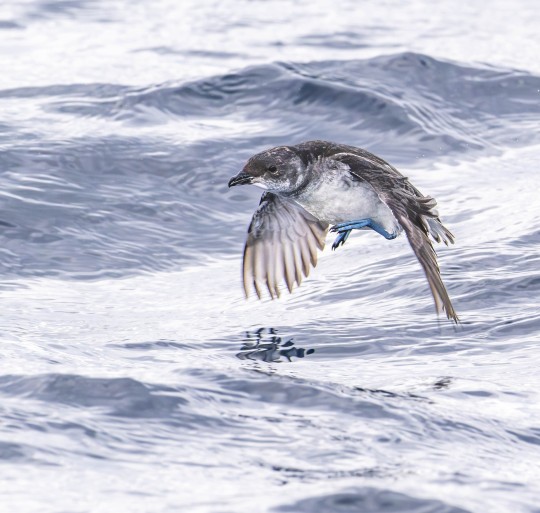
[2592/11080] Common diving petrel - Pelecanoides urinatrix
Order: Procellariiformes (tubenoses)
Family: Procellariidae (petrels, prions and shearwaters)
Genus: Pelecanoides (diving petrels)
Photo credit: William Richards via Macaulay Library
126 notes
·
View notes
Text
Endangered Seabirds Flourishing on Island for First Time in Decades as Invasive Rabbits Removed https://www.goodnewsnetwork.org/endangered-seabirds-flourishing-on-island-for-first-time-in-decades-as-invasive-rabbits-are-gone/
For the first time in over four decades, Peruvian diving petrels have four active natural nests on Chañaral Island after a dedicated conservation group cleared the island of a deadly invasive species.
This unique Chilean ecosystem has seen a resurgence in its seabird population following the successful removal of rabbits in 2017—and last year, the partners announced the first seabird chick born on the island in over 40 years.
The achievement is the result of a collaborative effort between Chile’s National Forestry Corporation (CONAF), Laboratorio de Ecología y Diversidad de Aves Marinas from the Universidad Católica del Norte, and one of the most serially successful wildlife organizations on Earth—Island Conservation.
The team discovered four active natural nests, including two with chicks, one with an adult, and a fourth with a fledgling. This breakthrough offers great hope for the birds, known locally as ‘yuncos’, that were classified as ‘Endangered’ by the International Union for the Conservation of Nature (IUCN) just four years ago.
In addition to the rabbit removal, Island Conservation scientists also implemented social attraction tools to encourage birds to return. This included solar-powered speakers that play petrel calls, a sign to passing individuals of high-quality nesting habitat nearby.
Today, thanks to all these efforts, the Peruvian diving petrel is now classified as just ‘Near Threatened’.
— This is just an excerpt—the rest of the article is very fascinating!
#good news#science#environmentalism#nature#environment#animals#conservation#chile#peru#Peruvian diving petrels#birds#endangered species#invasive species
63 notes
·
View notes
Text

The Seashore. Written by Jennifer Cochran. Illustrated by Kenneth Lilly, Patricia Mynott, James Nicholls, and George Thompson . 1973.
Internet Archive
187 notes
·
View notes
Text

Whenever someone puts "TBD" in an email, my brain goes "Thinking 'Bout Diving (petrel gryphons)."
Turresh the Shark fan art by Christina Halstead, who can be found over at https://www.instagram.com/risuquin/
#gryphon insurrection#gryphins#gryphon#fantasy#creature fantasy#griffin#griffon#gryfon#Risuquin#Christina Halstead#Tresh#Turresh the Shark#Sharkbeak#petrel gryphon#diving petrel gryphon
11 notes
·
View notes
Note
Grill him for information!!!
Okay on one hand yes you are right I should but on the other.
HOW DO I EVEN. Yeah hold on let me just. "Yes Petra by the way why the fuck did you have a massive gash in your side how did that happen"
.. He looks so sad.
#Sharp Answer#pokemon irl#pokeblog rp#pokeblogging#// this au is fun because not only does it give me a chance to “This is what Proton is actually like”#// but it gives me a chance to dive real deep into Petrel's character in particular
3 notes
·
View notes
Text
there was a whale watch in my county today so i went along, was rlly windy w loads of whitecaps out at sea so couldnt spot any cetaceans BUT it was perfect conditions for manx shearwaters!!! saw at least 700
everyone else was like "no dolphins today 😔" but i was just "👏FUCK👏YES👏MANX👏SHEARWATERS👏" the watch lasted for 2 hours but my dad & i stayed for 3 lol
#sam.txt#quite a lotta gannets too!#saw a few diving...they look so cool#saw a sandwich tern also#but FUCK YEAH SHEARWATERS#was looking out for rarer shearwaters (sooty & great) as well as storm petrels but no luck#still so fun to watch the manxies tho!! the way they bank in flight & never rise up more than a few feet above the sea#i am so autistic over seabirds its unreal but not many ppl know abt many species#so im just sitting here like 'EEEEEEEEEE' bc they excite me so much#autism hungry feed it seabirds <3
6 notes
·
View notes
Text
After flying by the rapid movement of its short wings for a space in a straight line, it drops, as if struck dead, and dives again.
"Journal of Researches into the Natural History and Geology of the Countries Visited During the Voyage of H.M.S. Beagle Round the World, 1832-36" - Charles Darwin
#book quote#the voyage of the beagle#charles darwin#nonfiction#bird#seabird#pelacanoides berardi#pelacanoides urinatrix#petrel#common diving petrel#flying#diving
0 notes
Text
Ardenna buchananbrowni Tennyson et al., 2024 (new species)

(Type specimen of Ardenna buchananbrowni, from Tennyson et al., 2024)
Meaning of name: buchananbrowni = for John Buchanan-Brown [discoverer of one of the two known specimens]
Age: Pliocene (Piacenzian), 3.06–3.36 million years ago
Where found: Tangahoe Formation, Taranaki, New Zealand
How much is known: Partial skeletons of two individuals, together representing most of the skull, much of the forelimb skeleton, and several vertebrae.
Notes: Ardenna is a genus of extant petrels. These seabirds feed on fishes, crustaceans, and cephalopods using a variety of foraging styles, including grabbing prey while swimming on the water's surface and diving underwater to pursue them. Within the genus Ardenna, the short-tailed (A. tenuirostris) and sooty shearwaters (A. grisea) have particular anatomical specializations for diving, such as flattened humeri (upper arm bones).
A. buchananbrowni also exhibits these adaptations in its skeleton, making it the oldest known diving-specialized member of this genus. It was smaller than most extant Ardenna species, and lived alongside a larger extinct species that lacked diving specializations, A. davealleni.
Reference: Tennyson, A.J.D., R.B. Salvador, B.M. Tomotani, and F.G. Marx. 2024. A new diving Pliocene Ardenna shearwater (Aves: Procellariidae) from New Zealand. Taxonomy 4: 237–249. doi: 10.3390/taxonomy4020012
#Palaeoblr#Birblr#Dinosaurs#Birds#Ardenna buchananbrowni#Pliocene#Oceania#Phaethoquornithes#2024#Extinct
60 notes
·
View notes
Text
Inktober Days 19-21
Day 19: "Plump"

Fat! Bear! Week! It’s perhaps the most beloved modern tradition to come out of a national park, when enthusiasts around the globe tune in to the Katmai webcams to see the results of a summer of brown bears gorging on salmon. We root them on, following their progress as they go from springtime skin and bones to mega-autumn chonk in just a few months. Watching these immense bears prowling Brooks Falls for leaping fish is so captivating that at some parks, during slow moments in the visitor centers, we would switch on the webcam feeds at the information desk. Rangers come from all different backgrounds, with all different affiliations and alma maters, but few things bring us all together like cheering on a wild bear eating wild salmon.
Day 20: "Frost"
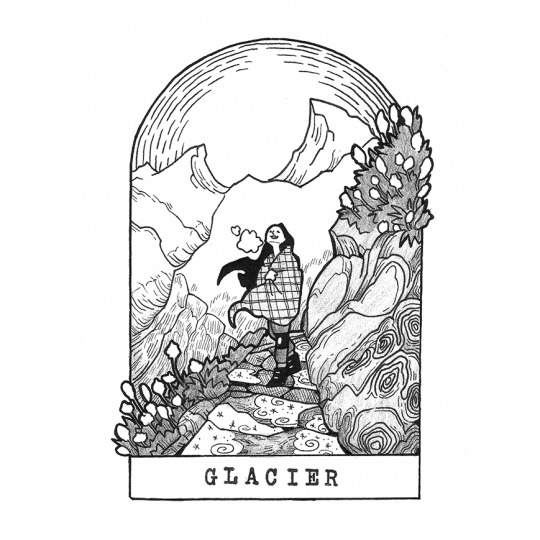
One of the privileges of working in northern mountain parks is the early coming of cool weather. Born and raised in South Carolina, few things make me feel more alive than a brush of autumn in August. I remember that first welcome moment in Glacier, when I climbed out of the government truck at Logan Pass for my shift in the high country. There was frost on the mountain slopes and a snap in the air. My breath fogged in front of my face, and the wind whipped through my park green sweater and jacket. Back at home, it was ninety-five degrees and humid, but on that morning, I swapped my flat hat for my fleece cap and spent the day bundled up on the Highline Trail, noting the huckleberries taking on their first tinge of crimson. I remember coming back to the tiny ranger station to find the woodburning stove crackling away, and I thought this must be what paradise was like.
Day 21: "Chains"

My first thought for this prompt was a chain of islands, but as I brushed up on Channel Islands, I realized it fits even better thanks to the chain of life that stretches from sea to land to air. Underwater terrain creates huge upwellings of nutrients that form the base of a food chain in the kelp forests, where vivid orange garibaldi and massive seabass swim among the waving fronds. Seals and sea lions spin and dive before hauling out onto beaches in noisy rookeries. Above them on the headlands, rare island foxes—only found on six of these islands and nowhere else in the world—scamper after mice and insects, occasionally coming to the shoreline for crabs. And in the skies, bald eagles, storm-petrels, and cormorants swoop down to pluck fish and other meals from the sea. And so life goes around and around on this scrappy cluster of islands.
Like these? Want extra illustrations and national park travel tips straight from the ranger's mouth? You can preorder Thirty-One Days of Inktober: The Artbook! It's a limited run--- snag yours now before they're gone!
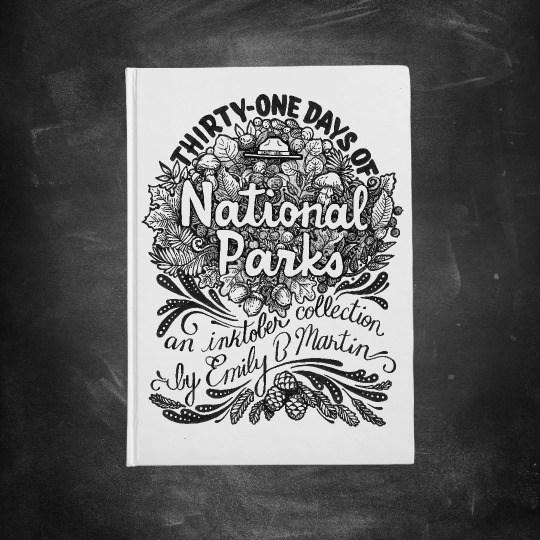

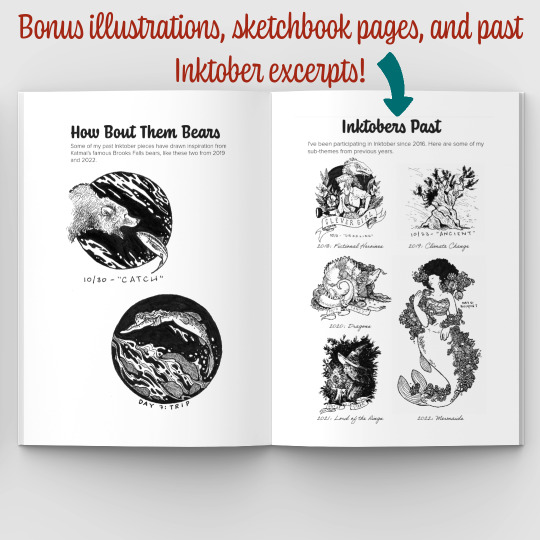
Incidentally, I'm trying to keep international shipping down by eating a bit of the cost myself, so I hope folks outside the US don't feel left out!
118 notes
·
View notes
Text
cw : mild blood / gore , average iots stuff
(under cut bc i love ya /p)
finished my design for Siren!Noah of the Waters ^^
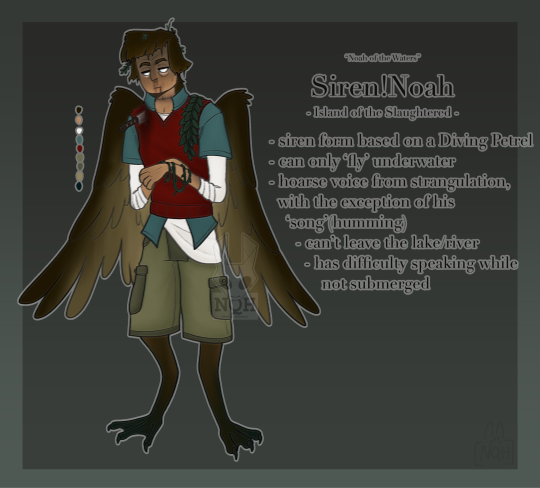
[Text(top to bottom):
""Noah of the Waters""
"Siren!Noah"
"- Island of the Slaughtered -"
"- siren form based on a Diving Petrel"
"- can only 'fly' underwater"
"- hoarse voice from strangulation, with the exception of his 'song'(humming)"
"- can't leave the lake/river"
"- has difficulty speaking while not submerged"]
feel free to use my design for fanart/writing/whatever(with credit ofc)! if you do, pls tag me too I wanna see :>
#artists on tumblr#digital art#art#total drama#island of the slaughtered#td noah#total drama noah#fanart#love him sm#cw blood#cw death#might make this into a speedpaint#the recording is perfectly my time length after all#we'll see#nqh art
60 notes
·
View notes
Text
thank you @ethanray for letting me write for your gorgeous @fall-for-tolkien piece young elwing with birds! i hope you like this short drabble sequence.
read it on ao3 here.
~
The daughter of Nimloth the White and Dior Eluchíl the Beautiful is born at night under a blaze of stars shining against the silver waters of the Lanthir Lamath. Star-Spray, her mother names her as she rests, for the beauty of it as it lights up her newborn face, each tiny eyelash picked out perfectly in the light. Eyes closed, she curls into her mother’s breast.
The song of the nightingale has scarcely been heard in Beleriand since the departure of Melian. But as the dawn rolls over the horizon, their chorus rings throughout Ossiriand. It seems to say: sister.
~
Hello, the terns that nest in the soupy marshes at Sirion say to Elwing, we love you.
We love you, say the gulls, as they dive between the painted houses of the Edain. We love you, say the petrels as they make their way overhead to faraway places unseen and unheard of.
It is a small thing, but it helps, in its way. Elwing is only three, and she is very lonely. She holds her secret kinship with the seabirds of Sirion close to her chest –- like her father’s gem, it is precious, and so it is worth caring for.
~
“Is it true you can speak to birds?” the boy Eärendil asks her, not long after his arrival at the Havens.
Elwing shrugs a little. “They speak to me. Sometimes they listen, too.”
“Wow.” He kicks lightly at the sand. “I wish I could do something like that.”
She looks at him, from the corner of her eye. There is an earnestness in his young face that she likes. “I could show you how I call them to me, if you’d like.”
She holds out an arm, whistles, and they watch together, smiling, as the seabirds dive down towards them.
~
Here, the gull tells her. Look.
Elwing follows it across the sand, to the small tidal pool where it perches. Floating in the water amid the hair-like weeds: a bottle of blue sea-glass stoppered with a cork. She pulls it out, and unrolls the parchment within.
Elwing, beloved , the letter begins, all is well on the maiden voyage of Vingilot. But I miss you so!
She feels herself begin to smile, and hugs the letter against her breast. The gull rises into the air, its work done, and Elwing’s heart soars with it, high among the stars and the clouds.
~
The fairy terns hop along the shore in a miniature ballet, while Elwing’s sons watch, enraptured. Friends? One tern asks, shy. Friends. She assures it.
She pushes her bare toes into the sand as she observes the scene. Sirion is at its best in high summer: the laughter of children ringing along the beach, the shimmer of the sun and the Silmaril against the waves, the migratory birds returning towards the warmer weather. The twins’ father will be home soon, too.
One brave tern steps onto Elrond’s chubby hand. Another flutters towards Elros. All around them, tender joy takes flight.
51 notes
·
View notes
Text
The garrulous Slagzogg
My response to this week’s BestiaryPosting challenge from @maniculum
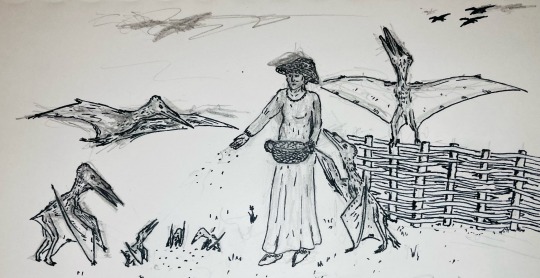
A little rough this week, but wanted to get it out there (perfect is the enemy of good :p).
Jinhao shark fountain pen with fine, hooded nib, with Monteverde Raven Noir ink, over initial 5.6mm HB pencil sketch.
Process and resoning notes below the cut...
"The Slagzogg marks the watches of the night by its constant cry. No other creature picks up the scent of man as it does. There are two kinds of Slagzoggs, domestic and wild. Wild Slagzoggs fly high, in a an orderly fashion, signifying those who, far away from earthly things, preserve a rule of virtuous conduct. Domestic Slagzoggs live together in villages, they cackle together all the time and rend each other with their beaks; they signify those who, although they like conventual life, nevertheless find time to gossip and slander. All wild Slagzoggs are grey in colour; I have not seen any that were of mixed colour or white. But among domestic Slagzoggs, there are not only grey but variegated and white ones. Wild Slagzoggs are the colour of ashes, that is to say, those who keep apart from this world wear the modest garb of penitence."
Okay, we know they fly. We know they have beaks. Hence, it's pretty obvious what kind of creature this is...
A pterosaur! Er... Well, there's no mention of feathers (which is probably reasonable...), perhaps I'm just tickled by the thought of medieval domesticated pterosaurs? I probably spent way too much time trying to draw a wattle fence, too. We have a farmer feeding her flock of domesticated miniature azhdarchid pterosaurs, while a few wild slagzoggs fly high overhead, looking down on their cousins below.
I went with azhdarchid pterosaurs since I felt that would be more visually distictive, and fit better in the picture given their more upright and distinctive method of locomotion on the ground. I also love the idea of a slagzogg 'village' cackling (like the one spreading its wings on top of the fence), clacking beaks, preening themselves, and generally making noise!
We also know that 'no other creature picks up the scent of man' as well as the slagzogg... We do know at this point that the bestiary authors love their superlatives almost as much as Pokedex descriptions, but we have no reason to doubt it. So, looking at modern archosaurs with a great sense of smell... Apparently, crocodiles actually have a fairly good sense of smell, but we're looking at birds to work out how best to represent this in a creature with a beak. Now kiwis have nostrils at the end of the beak, vultures also have a great sense of smell (though they completely slipped my mind until I was most of the way through), which left me with petrels... Petrels are diving seabirds with a distinctive 'tubenose' (their nostrils form a tubular nasal passage atop the beak), and use their sense of smell to detect prey (and their colonies) at sea. It's definitely a distinctive look!
What do they use their great sense of smell for (apart from identifying their keepers, one assumes)? Maybe these are truffle hunting pterosaurs? ;)
Actually, my first thought on reading the description was the dog vultures from the Judge Dredd comics (unfortunately I can't find any pictures online), until I re-read the description and noticed the reference to beaks!
This all raises an interesting question about how I (we? I don't want to assume too much) approach these challenges.
I feel like most of the time, I'm trying very hard to approach the prompts with a completely open mind; in many ways, a lot of the fun of these challenges is seeing what designs we come up with compared to the bestiary illustrators, given the same prompts.
Occasionally I'll have a pretty good idea what the creature is meant to be, in which case I will sometimes exercise a form of 'malicious compliance' where I'm either sticking as closely as possible to the description, or more rarely pursuing a parallel direction that I know is not the 'correct' one, in order to avoid drawing anything too close to the animal I believe the prompt is referencing.
Most rarely, I just have a cool idea from the prompt (like the Blisheag) and head off in that direction instead.
Guess which one this is :D
So what I'm also learning here is that I need more practice drawing humans, and drawing pterosaurs!
As an aside, this week I discovered this site;
It's basically a giant repository of links to various images and sites relating to medieval life and culture (so for example, I looked up the links for straw hats to get some medieval straw hat references this week...). There's so many links in here that some of them will inevitably have moved or expired, but it's potentially a really good source of references! I was able to find this image (partway through drafting the drawing) that I ended up taking heavy influence from;

#maniculum bestiaryposting#bestiaryposting#my art#pterosaur#azhdarchid#art challenge#slagzogg#Slagzogg
10 notes
·
View notes
Text

I really like the penguin allusion to Atlas, so here's another idea:
The same way penguin chicks jump from cliffs, it is the same for Atlas Academy First-Years doing a landing strategy. Instead of jumping into the water, they are flung across the water and have to land in the icefields to begin picking teammates. The icefields can still threaten to break and the students can fall into the water, but thankfully the temperature doesn't attract too much Grimm.
Just the Grimmed Petrels that fly around and look for prey, no big deal. /j
Though, they're not very big Grimm. They still behave the same as normal petrels: they wait for any first-year to trip and fall, and then the Grimm Petrel dives in to try and snatch them. But if they are outnumbered, they may abandon the plan and fly away. Grimm Petrels are devious creatures but they are not the strongest.
Also, we totally missed out on GRIMM WALRUS. Well, if we go to Vacuo, I hope we get Grimm Camels.
11 notes
·
View notes
Text


Mexican biologist Yuliana Bedolla
Off Mexico's west coast, the Baja California Pacific Islands are key global nesting sites for 23 seabird species and Natividad Island shelters 90 percent of the breeding population of the Black-vented Shearwater (Puffinus opisthomelas).
Mexican conservation biologist Yuliana Rocío Bedolla Guzmán, Director of the Marine Birds Project at Grupo de Ecología y Conservación de Islas (GECI) says that invasive mammals like cats and rats wiped out at least 27 seabird colonies in the past.
The researchers have been working with fishing cooperatives to decrease the likelihood of reintroductions that would lead to expensive eradication efforts.
"In 2021, we created the local community group “Líderes Comunitarios'' formed by enthusiastic and committed women who have received formal training on island biosecurity and bird identification, and are becoming agents of change in their communities," Bedolla says.
Recently, Bedolla won a 2023 Whitley Award from UK charity Whitley Fund for Nature (WFN) and will use the funding to boost the role of local women and fishing cooperative.
"The goal is to continue preventing the accidental introduction of invasive mammals on Natividad and San Benito Oeste islands by actively involving local leaders and fishing cooperatives in biosecurity protocols," she says.
"My Grain of Sand"
Bedolla grew up far from the sea in Moroleón, a small town in central Mexico, where she enjoyed being out in nature.
"But I had my Eureka moment when I learned to snorkel when I was 12 years old at a beach in Zihuatanejo, Guerrero, in the Mexican Pacific," she says adding that she remembered a feeling of amazement, wonder and a new sense of connection to nature.
"That experience was life-changing for me and marked the beginning of my journey as a conservationist," Bedolla says, "From that moment on, I knew I wanted to become a marine biologist and contribute with my grain of sand."
She would go on to study Marine Biology at the Universidad Autónoma de Baja California Sur in La Paz, Baja California Sur, Mexico, learning to dive and study coral reefs and associated invertebrates on several islands in the Gulf of California.
Bedolla would contact GECI in the course of her masters degree and years later, after a Phd in Germany, GECI offered her the directorship of the Marine Birds Project.
Bedolla says that being from the Global South helps her to bring diverse perspectives and approaches to scientific research, which can lead to more innovative and creative solutions.
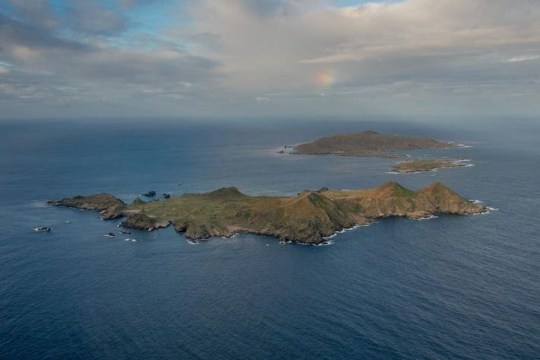
The San Benito Islands, which is among the islands Yuliana Bedolla is trying to protect from invasive species
Yuliana is a marine biologist, graduated with honors from the Autonomous University of Baja California Sur (UABCS).
She is a Master in Coastal Oceanography from the Autonomous University of Baja California (UABC) and a PhD candidate from the Justus Liebig University of Giessen in Germany. For her doctorate, she obtained a scholarship in Germany. Yuliana speaks Spanish and English and has basic knowledge of the German language. Her doctoral research focuses on the foraging ecology of three petrel species that nest in the San Benito Archipelago, in the Pacific of Baja California.
She began collaborating with the Ecology and Conservation of Islands Group, A.C., (GECI), in 2009 as a field biologist, and is currently the director of the Seabird Project, which aims to restore and conserve seabirds through the use of social attraction systems in conjunction with systematic monitoring, research and environmental education. She has carried out numerous research studies with national and international institutions. Her scientific publications in international journals focus on the response of seabirds to environmental conditions, the parasites that infect seabirds and the response of native fauna to the eradication of invasive mammals.
She has collaborated with several national seabird conservation programs and has been directly involved in environmental restoration projects in Isla Isabel, San Benito Archipelago, Banco Chinchorro and Arrecife Alacranes, related to the eradication of invasive rodents for the benefit of seabird colonies, among other island species. Her activities at GECI include project planning, staff coordination and supervision, applied research and monitoring, environmental education with local communities and dissemination of information in conferences and scientific reports and publications.
Source
#🇲🇽#Yuliana Rocío Bedolla Guzmán#STEM#mexico#baja california#pacific islands#animal#bird#rat#cat#GECI#2023 Whitley Award#Universidad Autónoma de Baja California Sur#Marine Birds Project#san benito islands#ecuador#banco chinchorro#scorpion reef#gulf of mexico#mexican#latina#hispanic#natividad island#Grupo de Ecología y Conservación de Islas
33 notes
·
View notes
Text

It's Saturday, so it's infusion day for me... but that's no reason not to post more GryphIns fan art that Tumblr hasn't seen!
Lewis Badger is one of the most prolific fan artists for the series around, especially since the audiobooks released. Badger wins the "first fan art" award for Henders, Xalt, Jer, Bruen, and probably a few other characters.
That said, it's this Turresh the Shark piece that often serves as a background for one of my monitors when I'm writing Tresh's scenes =]
For newcomers to the series, Turresh "Tresh" the Shark is a diving petrel + melanistic fishing cat gryphon often decorated with shark teeth, scary masks, and a basilosaurus-leather harness. She's the protagonist of the third book, Starling. Her nickname comes from the jagged scarring on her beak. Even before Starling, she was a fan favorite, and I always get excited letters when she's back in the series spotlight.
Okay, back to another... 7.5 hours of scig infusion. Suddenly, I feel a need to watch Jaws.
#gryphins#gryphon insurrection#creature fantasy#fantasy#griffin#gryphon#griffon#gryfon#Turresh the Shark#Tresh#Sharkbeak#Peruvian diving petrel#fishing cat
8 notes
·
View notes